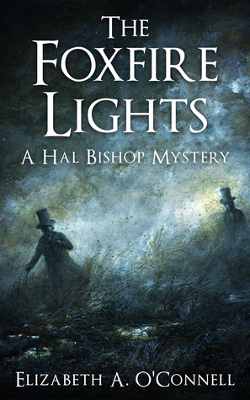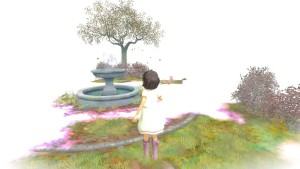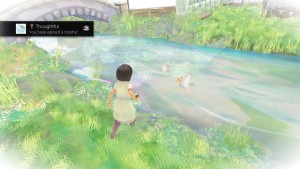Developer: tiger & squid
First Release: 8th September, 2015
Version Played: PS4
Length: Short
Beyond Eyes is a short exploration game, about a girl called Rae going to find her missing cat friend.
The marketing descriptions for Rae’s backstory are a bit of a mess, and don’t line up with what’s stated in the game. In the game, Rae is blinded in a fireworks accident. She becomes reclusive, staying in her garden, as a reaction to the trauma of the accident. That summer, she befriends a cat she calls Nani. The seasons travel through to winter, Nani starts to visit less and less often, and by spring he’s disappeared. Rae heads out to find him.
The difference is the marketing versions say she’s been blind since she was a toddler. However, the game shows her as near the same age (and wearing the same clothes) when she has her accident. The passing of the seasons would make it about a year later when she heads out. This also fits better with her general level of skill in moving around. If she had been blind since she was a toddler, it would come across as strange that she wasn’t more skilled at moving around. This would mean she’d been blind for most of her childhood, which just doesn’t fit.
But anyway, if I hadn’t read those descriptions, I’d have said this takes place about a year later.
The strength of the game is the way the world is painted around Rae. As she uses her other senses to navigate, she imagines the world, and it appears around her. This means she sometimes gets things wrong, such as thinking cloth flapping in the wind is a clothesline, when it’s a scarecrow. She might imagine a gate as closed because it was when she first encountered it, but someone’s opened it since then. As this representation exists only in her mind, it’s also influenced by her current mental state. When she’s frightened, the colours are less bright. When she’s confused, areas can disappear.
Though there are some sadder/tenser moments, it’s overall a gentle experience. Rae’s world is an idyllic village with flowers and birds singing, rendered in watercolour. The threats she faces are common ones, such as crossing the road or a loud dog.
I liked that Rae’s accident was not portrayed as the end of her life. Withdrawal is a normal (though not the only) response to trauma. The key here is it’s also showing her facing that, by leaving to find Nani. Life carries on.
There were two things I noted as not ideal in the portrayal of blindness. It’s odd that Rae’s eyes are closed all the time. Even in cases where the eyes are removed, the eyelids are not usually sewn shut in humans. I wonder if this was done to avoid showing damaged or absent eyes. The second point also doubles as a gameplay issue. There’s a misconception that blind people can’t move quickly. That blind children don’t run when they play, adults never run for the bus, and even a fast confident walk is seen as out of the question. This isn’t true. It’s natural for someone who is re-learning how to navigate to be cautious, but slow movement speed is not inherent to being blind.
The gameplay issue being Rae moves slowly all the time. For the initial exploration, this speed is fine. But it gets painful when backtracking to explore all the areas, which isn’t a good gameplay choice for an exploration game. It makes sense both from a real world perspective, and a game perspective, to have her pick up the pace in areas she’s already been. Even a cautious child is going to move faster going back down the path she knows is fine. It also would have been a nice touch if her basic walk had slowly increased in speed during her adventure, as she got more confident.
In terms of gameplay, I would have liked more events. There were some already in the world, such as being able to feed flowers to a cow, and finding memories of Nani. But there were also places that felt empty. Some of these had objects that could have triggered events. I didn’t feel the balance of things to find, versus the time taken to explore, had been hit.
Accessibility options for blind players would have been good, such as the option to have a narrator reading the story (it’s text only) and controller vibrations when hitting obstacles. Also worth noting the undiscovered areas are white, which can be a migraine or motion sickness trigger for some people. If you’re in that category, keeping game sessions short is advisable.
Overall, Beyond Eyes is a nice addition to the exploration genre. It has some strong points, such as the way the world is painted from Rae’s perception and the beautiful artwork. I would have liked a faster backtracking speed and more things to find, but this didn’t stop me enjoying it. Fans of quieter exploration games and walking simulators are likely to enjoy the game. It took me around six hours to finish everything, including reruns for trophies.
 Series: Hal Bishop Mysteries, #2
Series: Hal Bishop Mysteries, #2 First Published: 29th March, 2016
First Published: 29th March, 2016

